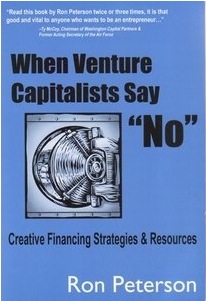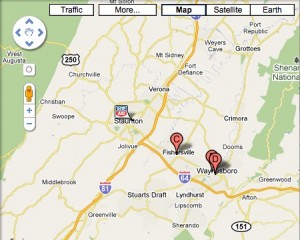Resources for Life Sciences Entrepreneurs and Venture Capitalists
October 27, 2010
 While researching trends in longevity and their significance for start-up companies, I came across an extraordinary report by investment banker Ronald Peterson. Entitled “Technology Transfer and the Life-Sciences,” the report is chock-full of two things:
While researching trends in longevity and their significance for start-up companies, I came across an extraordinary report by investment banker Ronald Peterson. Entitled “Technology Transfer and the Life-Sciences,” the report is chock-full of two things:
1. Examples of companies who have licensed technology, then made a fortune off it.
2. Contact information for anyone pursuing similar ambitions.
A veteran venture capitalist, Peterson thinks it is too slow and too risky for biotechnology companies to develop their own proprietary technology:
Arguably the best way to form a new biotechnology company (or any technology company for that matter) is to transfer a technology that has already been largely developed and form a company by adding management, marketing and other needed talent.
Peterson’s formula for success is basically the blueprint for a Minitrends Adventure. First, locate a technology to exploit. Peterson provides links to dozens of sources, including exchanges where universities list thousands of technologies available for licensing. Next, attach that technology to your own entrepreneurial marketing team. Third, fund the operation with venture capital.
While venture capital is tight these days, it is not impossible to find. Peterson wrote a book in 2003 on how to find venture capital when markets are tight. The book is currently out of print, but available used through Amazon and other retailers. It’s called When Venture Capitalists Say “No”: Creative Financing Strategies and Resources.
Technology Transfer (TT) — the Minitrends route Peterson recommends — is also a winning strategy for the organizations that license their inventions to entrepreneurs. A study by the Milken Institute shows that universities reap $6 million in licensing fees for every $1 million spent on technology transfer operations.
This amazing article by Peterson, which is as long as a book, contains resource after resource, plus example after example to get you inspired. For example, Neven Vision licensed face recognition technology developed at the University of Southern California, secured $200,000 in venture capital funding, and later sold the firm to Google for $40 million. If this article doesn’t get your entrepreneurial blood boiling, you must be in cryonic suspension.
Ronald Peterson is president of Three Arrows Capital Corp., a U.S. investment banking firm that has helped fund hundreds of emerging high-growth companies. He has over 30 years of experience on Wall Street as either a vice-president or registered representative with companies such as Merrill Lynch and Paine Webber. He can be reached at Three Arrows Capital, 7517 Westfield Drive, Suite A, Bethesda, MD 20817; 301-229-6240; fax: 301- 229-5462; email: tarrows@comcast.net.
STEVE O’KEEFE
News Editor, Minitrends Blog
Source: “Technology Transfer and the Life-Sciences,” by Ron Peterson, 01/01/08
Cover image of When Venture Capitalists Say “No”: Creative Financing Strategies and Resources is used under Fair Use: Reporting.
The Future of Futurists Is Uncertain
October 22, 2010
In a pair of interesting articles for MIT Technology Review, one of the best futurists in the business, Tom Simonite, says the future for futurists is not what it used to be. It appears that computers might be getting better at forecasting the future than futurists are.
Simonite is no slouch when it comes to predicting trends. Not only is he the IT editor for MIT Technology Review, he’s also the online technology reporter for NewScientist. On October 4, Simonite reviewed a new search technology by startup company Recorded Future that doesn’t just find what’s out there, but what will be out there, related to any search term.
The search engine works by looking at patterns of when a company says it will release a new product, for example, compared with the actual dates of product releases. The search engine can then make predictions about when a promised new technology will actually become available. Recorded Future founder Christopher Ahlberg told Simonite how it works:
[Recorded Future uses] a constantly updated index of what Ahlberg calls ‘streaming data,’ including news articles, filings with government regulators, Twitter updates, and transcripts from earnings calls or political and economic speeches. Recorded Future uses linguistic algorithms to identify specific types of events, such as product releases, mergers, or natural disasters, the date when those events will happen, and related entities such as people, companies, and countries.
In an earlier piece for MIT Technology Review, Simonite reviewed a new search technology developed by Yahoo, called “Time Explorer.” Like Recorded Future, Time Explorer searches through articles for predictions made about the future, then plots the results on a timeline so that browsers can see what is likely to occur on any given topic in the near future.
The future for Recorded Future looks bright. The company has received funding from the venture capital arms of both Google, Inc., and the Central Intelligence Agency. Being merely human, it’s hard for me to predict when this technology will be coming to a search engine near you.
STEVE O’KEEFE
News Editor, Minitrends Blog
Source: “See the Future with a Search,” MIT Technology Review, 10/4/10
Source: “A Search Service that Can Peer into the Future,” MIT Technology Review, 8/25/10
Video courtesy Recorded Future from the company’s YouTube Channel.
Go Daddy Innovates an Online Advertising Minitrend
October 20, 2010
 Last week, I used the online advertising market to illustrate the difference between megatrends and Minitrends. Google has prospered tremendously from the mega-shift in advertising away from print and broadcast media. In doing so, Google has pioneered many Minitrends, including inserting fresh ads into old content.
Last week, I used the online advertising market to illustrate the difference between megatrends and Minitrends. Google has prospered tremendously from the mega-shift in advertising away from print and broadcast media. In doing so, Google has pioneered many Minitrends, including inserting fresh ads into old content.
Google isn’t the only one innovating in this space. Last week, domain registrar and host Go Daddy announced a clever new service called AdSpace that makes online advertising more accessible to small and medium-sized businesses (SMBs).
Go Daddy’s AdSpace allows entrepreneurs to fill out a simple form about their business, and Go Daddy takes it from there. The company’s online advertising experts follow this fascinating chain of activities:
- They create a web page based on the info you provide.
- Their keyword specialists then select keyphrases for your business.
- Next, they purchase search ads on Google to drive visitors to the site.
- Then they provide phone numbers and email addresses for customers to contact you.
- Finally, they track all the inquiries, including recording all phone calls and storing all emails.
Go Daddy’s AdSpace program takes advantage of expertise and technology to provide quick, inexpensive access to sophisticated online advertising tools. Go Daddy founder and CEO Bob Parsons describes the new program:
AdSpace was designed for small businesses wanting to leverage the power of the Internet — businesses that know they need to advertise online, but don’t have big budgets or tech experts to feel comfortable taking financial risks.
Jake Widman, a longtime tech writer who himself has followed the trend away from print magazines to online journalism, covered the story for InformationWeek‘s SMB blog. Widman explains how Go Daddy’s unique dashboard works:
The service also provides a dashboard for tracking the email and phone leads generated by the ad page. Phone calls are recorded and can be played back later — before a followup sales call, for example. The Dashboard also provides time-based tracking functions, so the company can see if the ad campaign is increasing leads or sales and by how much.
Go Daddy’s AdSpace service starts at just $50/month. Who would have thought that you could get a custom-built website for free with the purchase of a modest search advertising program? This is just one more novel example of entrepreneurs such as Bob Parsons teasing new innovations out of advances in technology. Go Daddy, Go!
STEVE O’KEEFE
News Editor, Minitrends Blog
Source: “AdSpace Innovation Puts SMBs in the Online Advertising Game,” Go Daddy News Release, 10/11/10
Source: “Go Daddy Launches SMB Online Advertising Tool,” InformationWeek SMB Blog, 10/13/10
Google’s Surge Highlights Minitrends in Online Advertising
October 15, 2010
Yesterday, Google Inc. announced an amazing 23% jump in year-to-year revenue, from $5.95 billion in third quarter 2009 to $7.29 billion in third quarter 2010. The print and broadcast media, who compete with Google for advertising budgets, must have choked reporting those numbers. That is a stunning amount of growth in a non-essential service while much of the globe claws its way out of recession.
Google derives most of its revenue from online advertising, a megatrend that began 16 years ago with the release of the first Web browser. As the Internet penetrates into more homes and workplaces around the world, the Internet advertising market will continue to boom. Advances in technology promise to reduce the costs of serving ads while generating a variety of Minitrends in the online advertising market.

Screen capture from a Perry Mason clip on YouTube showcasing a text ad for Bing across the bottom of the screen.
One of the brilliant Minitrends pioneered by Google is the ability to put fresh ads into stale content. If you have a DVD with preview trailers on it, you know those ads get stale in a matter of weeks. What if every time you watched the DVD, fresh trailers appeared? That’s what Google achieved with YouTube advertising. Now, when you watch an old Perry Mason clip on YouTube, you get an up-to-date ad. In the screen capture of this clip, shown on the right, the ad is rather hilarious. It’s from Google’s rival, Bing, trying to get you to watch videos at Bing instead of YouTube.
Another Minitrend in online advertising is being able to quickly profile a browser and adjust the ads accordingly. Now you not only get fresh ads, you also get targeted ads based on what the ad server knows about you. That’s why if you clicked on the YouTube video above, you most likely saw a different ad completely, based on your past Web history and search patterns.
Part of the online advertising megatrend is display advertising, which is on pace to generate $2.5 billion out of Google’s projected $30 billion in 2010 revenue. Henry Blodget, one of the most astute analysts of Internet stocks and the editor-in-chief of Business Insider, which runs on the San Francisco Chronicle‘s SFGate site, isn’t impressed with the trend in Google’s display advertising revenues:
The reason Google is so amazingly profitable is that it keeps 100% of the revenue for AdWords — the sponsored search results that appear on Google’s search pages.
Since Google has not yet stooped so low as to serve display and video ads on its own pages, however, it has to share display revenue with content partners. The average split for this display revenue is probably on the order of 70% to the partner and 30% for Google. The same goes for YouTube: Google does not produce videos itself, so it has to share revenue with partners.
One promising Minitrend in display advertising — technology to serve video ads into YouTube videos instead of the text ads that currently appear — could dramatically increase the display ad revenue generated by YouTube. Video ads are dynamically inserted into streaming video at NBC, Comedy Central, and many other television websites, although it does not yet appear they are customized for individual browsers.

Google Maps Search for "Walgreens" with a Pin Ad for RiteAid
Another megatrend that Google is benefiting from is the mobile advertising market, where searches on Google have grown 500% in the last two years. Google’s mobile advertising revenue is expected to total $1 billion in 2010. One of the Minitrends within that megatrend? The ability to put ads into Google Maps. Recently, while searching for a Walgreens on my iPhone, I was presented with logo pins for every RiteAid in the area.
Congratulations, Google, on milking the megatrends like no one else. And congratulations to all the entrepreneurs who have fueled that growth by pursuing the Minitrends that make it possible.
STEVE O’KEEFE
News Editor, Minitrends Blog
Source: “Sorry, But Google’s Still A One-Trick Pony — That ‘$2.5 Billion Of Display Revenue’ Is Not As Impressive As It Sounds (GOOG),” San Francisco Chronicle, Business Insider, 10/15/10
Screen capture from video at YouTube is used under Fair Use: Commentary.
Screen capture from Google Maps is used under Fair Use: Commentary..


